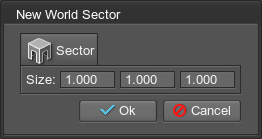Sector
A sector is a cuboid shaped object that culls all of the objects outside its volume. Sectors usage is very convenient for designing of indoor spaces. Sectors are connected by portals.

See also
- WorldSector class to edit sectors via UnigineScript
Creating a Sector
To create a sector, choose the Add World Sector option in the list of nodes of Editor panel. In the opened creation dialog window specify initial parameters:

A Creation Window
| Size | The size of the sector's bounding box along the X, Y and Z axes, in units. |
|---|
After the initial parameters are set, click Ok and place the sector somewhere in the world.
Editing a Sector
In the Sector tab you can adjust the following parameters of the sector:

A Sector tab
Bounding Box Parameters
A set of bounding box parameters:
| Size | The size of the sector's bounding box along the X, Y and Z axes, in units. |
|---|
Last update: 2017-07-03
Help improve this article
Was this article helpful?
(or select a word/phrase and press Ctrl+Enter)